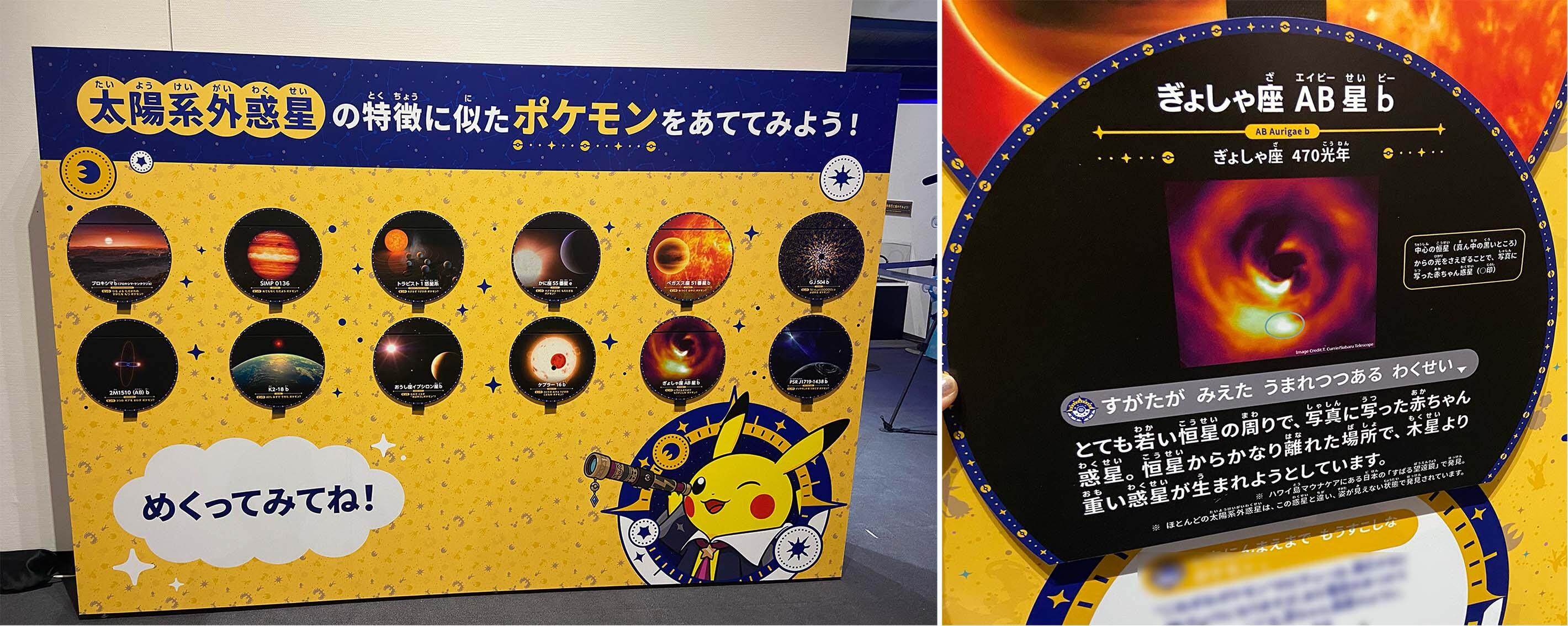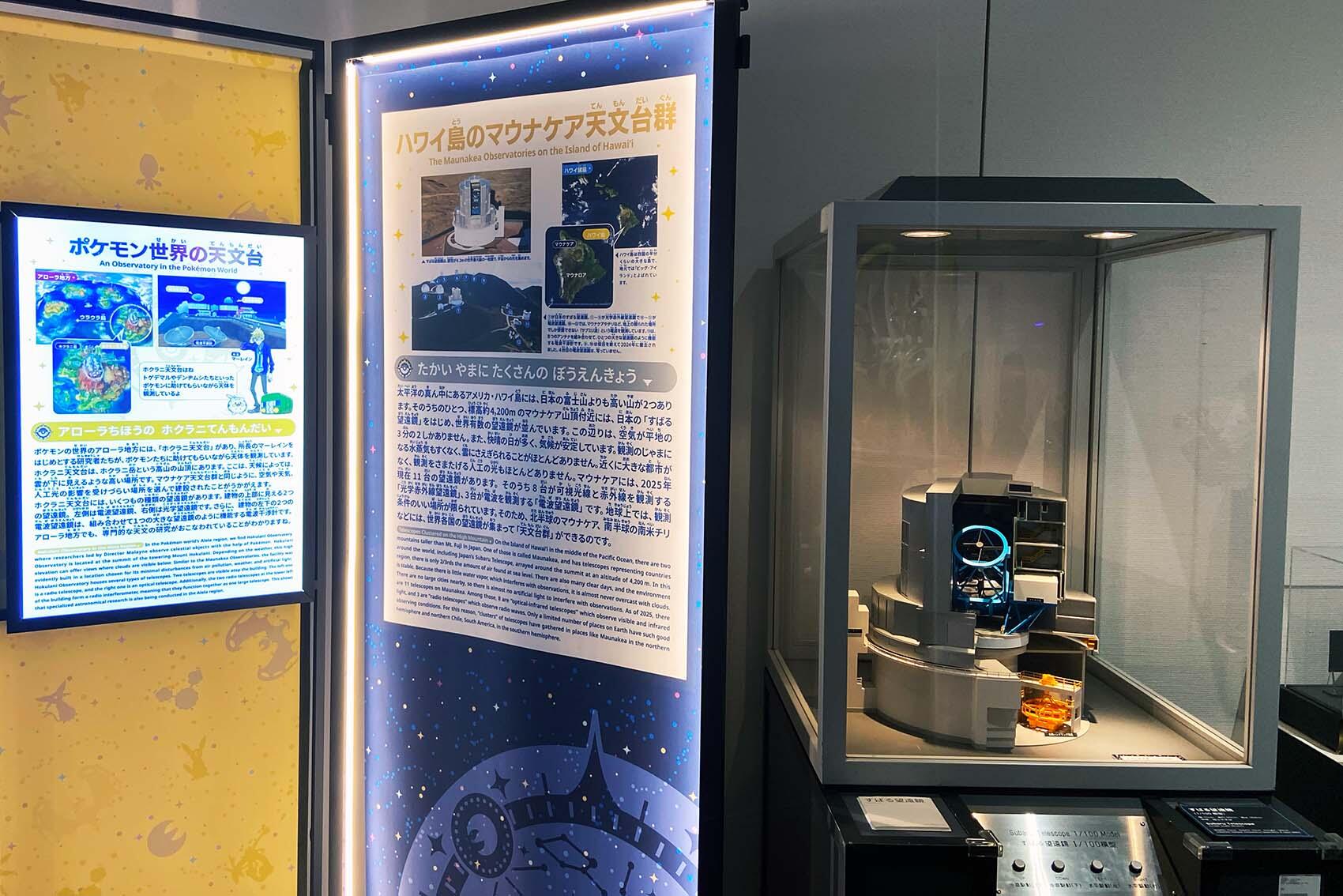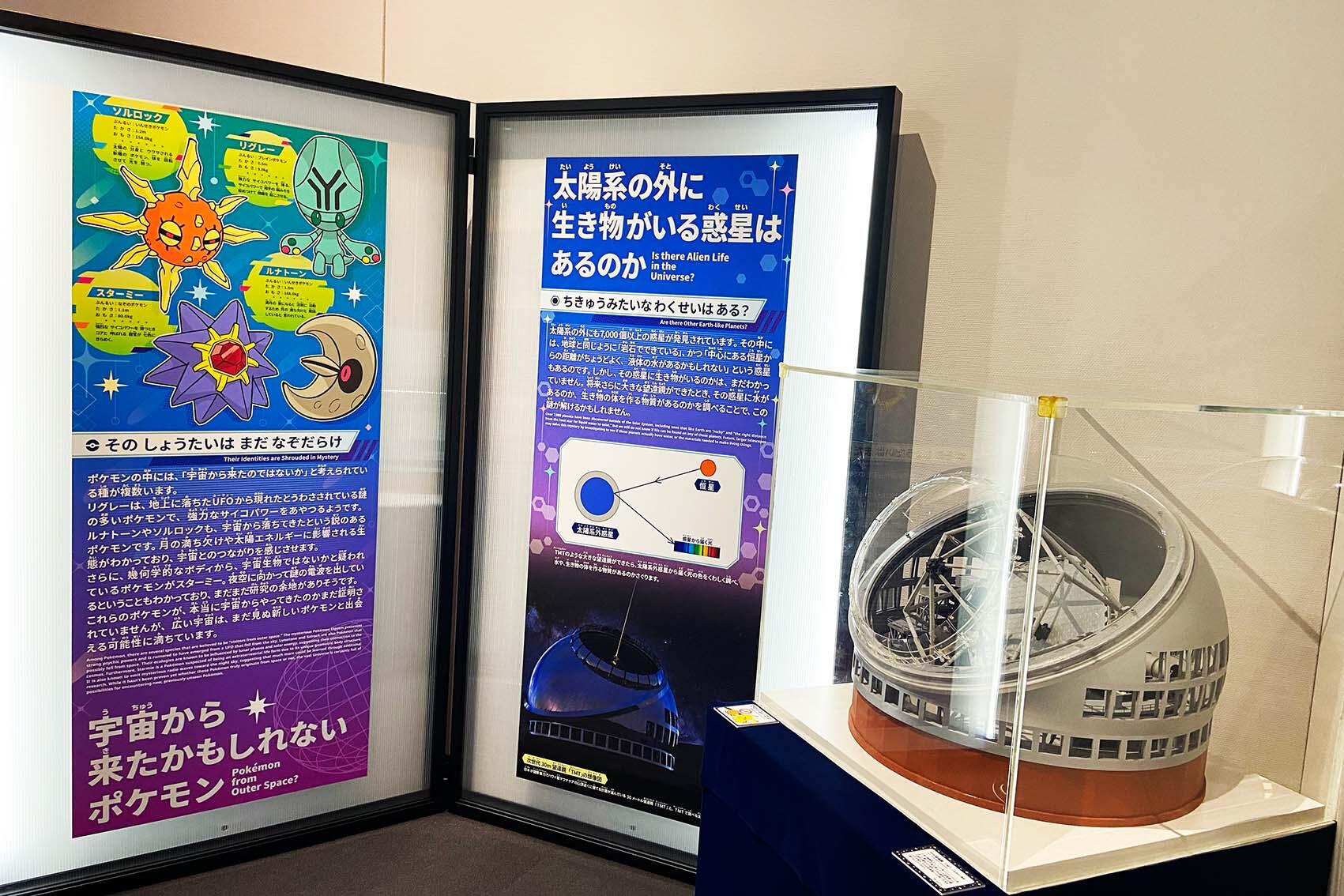The National Astronomical Observatory of Japan (NAOJ), in collaboration with The Pokémon Company, has launched the "Pokémon Astronomical Observatory" traveling exhibition. This exhibition opened on November 1, 2025, at the Sagamihara City Museum in Kanagawa Prefecture, Japan. It offers visitors unique opportunities to learn about the wonders of the Universe. The curiosity that drives us to explore the mysteries of the Universe is akin to the excitement of discovering and encountering the mysterious creatures known as "Pokémon." Fueled by this sense of suspense and thrill, the exhibition invites visitors to delve into the fascinating worlds of both outer space and Pokémon.

Figure 1: Entrance of the Pokémon Astronomical Observatory. This photo was taken during the opening ceremony on October 30, 2025, with Stargazer Pikachu. (Credit: NAOJ)
The exhibition consists of Area 1: "From Observatories to the Universe," Area 2: "Exploring Our Cosmic Neighborhood," Area 3: "Seeing the Invisible Universe," the "Minior Tunnel" connecting Areas 3 and 4, Area 4: "Earth, the Planet of Life," and Area 5: "Exploring Unsolved Mysteries."
In each area of the exhibition, a theme related to Space is paired with related Pokémon. For example, Area 2 introduces the planets of the Solar System alongside Pokémon that share similar characteristics. This pairing allows visitors to enhance their understanding of both the planets and the Pokémon. Area 3 highlights the life cycle of stars with Cosmog, a Pokémon whose evolution resembles the process of star formation. The exhibition also introduces 12 exoplanets (extra-solar planets), each a unique world that differs from those in the Solar System. These exoplanets are showcased in a quiz format, where each is matched with a Pokémon that possesses similar traits (Figure 2). In Area 5, three unresolved mysteries of the Universe and mysterious Pokémon are displayed side by side, inviting visitors to explore the unknowns of both worlds.

Figure 2: Exoplanet Quiz Panel (left). When you lift the flap, you can read about the planet's characteristics and the Pokémon that share similar traits (right). GJ 504 b and AB Aurigae b, discovered by the Subaru Telescope with direct imaging, are included in the 12 featured exoplanets. Discover which Pokémon possess similar traits to the planets at the exhibition venue! (Credit: NAOJ)
"Although many Pokémon are related to outer space and the Pokémon world has a good connection to astronomy, it was unclear how to integrate the two worlds for the exhibition. After a series of in-depth discussions at our monthly all-hands meetings and additional conversations among the NAOJ Pokémon team, we realized that both celestial bodies and Pokémon evolve—they change their appearance and characteristics while remaining the same individual. This similarity between celestial bodies and Pokémon turned out to be a significant connection. Additionally, one member of the NAOJ Pokémon team noted that Pokémon evolution can be categorized into two types: 'stellar-type' and 'planetary-type.' The evolutionary line of a star, including its lifespan and how it ends its life, is determined by initial mass at birth. Similarly, some Pokémon have predetermined evolution lines. In contrast, planets like Venus, Earth, and Mars, which may have had similar initial compositions, can evolve into widely different forms based on their environment, such as the distance from the host star, the planet's mass, or the composition and thickness of their atmospheres. Likewise, certain Pokémon are capable of diffrent evolutions, adapting their body structure to changes in their surroundings. This was a big epiphany for us!" explains Kumiko Usuda-Sato, a Public Outreach Specialist at Subaru Telescope, NAOJ, who has been involved with the Pokémon Astronomical Observatory project from the very beginning.
The summit area of Maunakea on the Island of Hawai`i, where the Subaru Telescope is located, is where astronomy intersects with the Pokémon world. The Alola Region in the Pokémon games "Sun & Moon" is believed to have been inspired by the Hawaiian Islands, and Hokulani Observatory in the game resembles the Maunakea Observatories. "I am very impressed that Hokulani Observatory has radio telescopes. In many cases, when non-astronomers depict astronomy, they only show optical telescopes, but Hokulani Observatory includes both optical and radio telescopes, just like Maunakea! I was eager to share that excitement with the exhibition visitors, and I presented my comparison between Hokulani and Maunakea to team members from The Pokémon Company. As a result, we created comparison panels (Figure 3). I cannot express how happy I am that these panels are displayed in the exhibition," Usuda-Sato enthusiastically explains.

Figure 3: Comparison panels displayed next to the Subaru Telescope model (far right) in Area 3, showing the observatory in the Pokémon world (left) and the Maunakea Observatories on the Island of Hawai`i (right). (Credit: NAOJ)

Figure 4: Area 5, "Exploring Unsolved Mysteries," includes an introduction of the Thirty Meter Telescope (TMT), which NAOJ promotes through international collaborations. The panel titled "Is There Alien Life in the Universe?" explains the role TMT is expected to play in solving the mystery (left). The TMT model (right) is displayed next to the panel. (Credit: NAOJ)
Another lure of this exhibition is that visitors can explore the evolution of Japanese astronomy, connecting the past, present, and future. In Area 2, you can learn about early astronomy through two types of old calendars from NAOJ's invaluable collection of historical archives. Area 3 focuses on our modern understanding of the Universe, as revealed by currently operating telescopes. Area 5 explores next-generation research to address unresolved cosmic mysteries.
The exhibition is being held at the Sagamihara City Museum until January 12, 2026. After that, it will be hosted in various science museums and other exhibition spaces across Japan. For more information, including ticket purchases and the upcoming exhibition schedule, please visit the Pokémon Astronomical Observatory official site (in Japanese language). This unique exhibition, where astronomy meets the Pokémon world, invites you to immerse yourself in two worlds filled with mysteries and discoveries. In the future, you may uncover the secrets of both the Universe and Pokémon.
©Pokémon. ©Nintendo / Creatures Inc. / GAME FREAK inc. TM, ®, and character names are trademarks of Nintendo.


